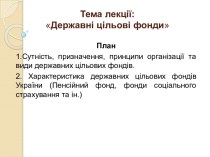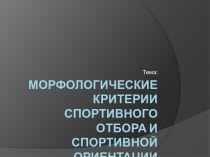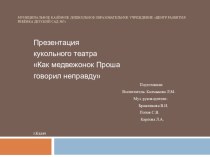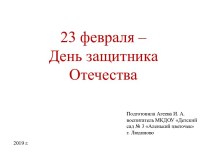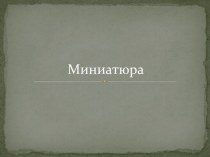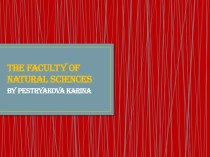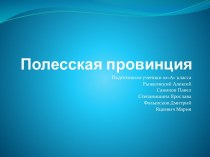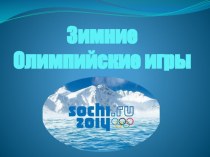Слайд 2
An artistic method
Artistic method or creative method (from
Greek – methodеs – the way of knowing) means
the principle of reflection of reality. There are:
REALISTIC method that reflects reality objectively, according to the laws of the life and UNREALISTIC one that reflects reality according to norms and rules set by the author or authors.
Слайд 3
Realism
Realism (from Latin – realis – material)
1)
the creative method in literature and art on the
base of which there is realistic re-creation of reality in ‘definite sensitive images’;
it is the common typological principle of life description that suggest the re-creation of reality in the forms of life as it is,
true description of details, true description of typical characters in typical circumstances;
2) the conception that characterizes the cognitive function of art: the truth of life reflected by the specific means of art, the measure of its penetration into reality, the depth and fullness of reality understanding.
Слайд 4
Realistic artistic method
Thus, realism is the main tendency
of historical development of art, inherent to its various
kinds, styles, epochs (realism in ancient and Middle Age folklore, in art of antique and Enlightenment, in the literary creative activity of Byron and Pushkin).
Слайд 5
Realism is re-creation of life in its regularities
and typical features.
Realism in literature is the faithful
description of personages’ characters, their psychology, and the psychology of their milieu, time and surroundings.
Слайд 6
Its main particularities are
the reflection of life
through typification in the images in accordance to the
essence of life phenomena;
the longing to wide reflection of life in its contradictions, deep regularities and development;
the will to describe man in his interrelations with the milieu: the inner world of personages, their behavior show the signs of TIME;
big attention to social - everyday background of life;
universality in human description;
social and psychological determinism;
historical point of view on life.
Слайд 7
The main criteria of this artistic method -
is the closeness to reality, longing to direct truthfulness
of description, ‘re-creation’ of life in the forms of life itself. It is acknowledged right of author to enlighten all sides of life without any limitation. There is a big variety of artistic forms.
Слайд 8
Normalization of literature – нормативность литературы
is one of
the principles of artistic reflection of reality contrary to
realism.
In essence, all literary directions, trends, if they are not realistic, written by the method in which the measure of conditionality is defined by the norms, rules and conditions.
There are two artistic or creative methods - realistic and non-realistic. The first one recreates primary reality in life-like forms and the second one recreates life in its conational subjective fantastic forms,
first one is productive (forming the artistic system) and second one is non-productive (forming one literary direction).
Слайд 9
Method
Method in its typology has stable and recurrent
set of the main particularities of literary creation, that
expressed either in the selection of life phenomena or in the principals of choice of expressive means of artistic description of the writers of the same direction, trend or school. The objective difficulty in the definition of artistic method is that ‘artistic method is the category of aesthetics and deeply substantial(содержательная).
Слайд 10
It is impossible to define method nor through
the formal ways of image construction or the ideology
of a writer. It is the set of ideological – artistic principals of reality description in the light of definite aesthetic ideal. The worldview of the author is naturally included in the method only in the case if it is coincided with the talent of the author, with his\her poetical thinking, but it does not exist in a literary work in the form of social political tendency”. (N.A. Gulyaev).
Слайд 11
The category of an artistic method
is connected
with the categories of types of creativity, from one
side, and with the category of style, from another side. The modern literary critics as well understand the term ‘the type of creativity’ as an artistic method, that is the principal of artistic thinking (realistic or non-realistic), and the layers of imaginative literature (prose and poetry). In V BC Sophocles aphoristically defined two contradictory types of artistic thinking – “he (Euripides) describes people as they are in the real life, but I describe people what they have to be”.
Слайд 12
Literary direction
is the common set of ideological –
aesthetical principles that belong to one group of writers
during long time, united by one aesthetical creative program.
Слайд 13
Literary direction
Literary direction appears when the writers achieve
the definite level of creative consciousness and together form
some common principals of their creativity in a program, commenting them through the theory and recreating them through practice in their literary works. Literary direction may be also seen as definite historical manifestation of the artistic method inside of artistic system. The belonging of writher to one or another literary method suggests the common cultural -aesthetical traditions, sameness of worldviews, unity of social and cultural – historical situation of creative activity (the regularities of common historical development).
Слайд 14
The variety of literary directions
But the attitude to
the problems, ideals of writers and artistic conceptions may
be various. Through the definite historical forms of the method there are the literary directions of classicism, romanticism, critical and socialistic realism.
Слайд 15
Classicism
(from Latin classicus – exemplary, classic, standard) is
a literary direction that appeared in some European countries
at the beginning of XVII century, at the base of which is the affirmation of antique art as the highest example of artistic ideal, and the works of antique literature as the artistic standards, norms.
Слайд 16
Classicism
The representatives of literature and art, leaded by
the ideal representation of state in the absolutist epoch,
affirmed the idea of priority of state interests above the interest of a human being. The limited system of classicism needed the strict division on genres, respecting the rules of three unity, the wholeness of composition and monolithic character of the main personages, strict poetic rhymes and norms.
Слайд 17
Sentimentalism
(from French sentiment – feeling, sensitiveness, sensuality)
an artistic direction of the second part of XVIII
century, developed during Enlightenment as the particular reaction on its rationalistic stage in the form of classicism. Typological features of sentimentalism are
appeal to feeling of a personage,
affirmation of self value of individual, the world of his\her feelings,
democratization of a personage.
Слайд 18
Sentimentalism
The preservation of the tradition of Enlightenment such
as the creation of positive personage that was born
by ‘nature’ not by reason. There are characteristic features of sentimentalism – subjective approach to reality, refusal to follow antique ideals, the appeal to the genre of epistolary, diaries, confession, notes of travelers (Sentimental travel, by Stern, the title gave the name of this direction), poems, elegies;
the Enlightenment, anti -feudal tendency,
melancholic – sentimental pathos of literary works,
idealization of patriarchal form of life and critique of feudal – bourgeois relations.
The representatives of European sentimentalists are Richardson, Russo, Radizhev, Karamzin.
Слайд 19
Romanticism
is the artistic method in literature and art,
at the base of which is the will of
man to absolute freedom, spiritual perfection, unachievable idea, in the combination of non- perfection of the real world. The first theorists were Fredrick and August William Shlegel that published the program of Romanticism. In a broad sense this term is used sometimes as the name of method, considering in the mind the usage of exceptional personages and plots, re-creation of reality through subjective author’s ideals, the development and strengthening the conditional forms of creation.
Слайд 20
Romanticism
Tragic two worlds: the hero recognizes the non-perfection
of the world and people, suffers from communication with
them and at the same time he wants to live in this world, with these imperfect people, dreams to be recognized by them and admitted in society.
The main artistic quality is the dominate of subjective upon objective sides of the world, the wish not to re-create, but create reality, the will to a leading position some extreme, exceptional things (in characters as well as in circumstances).
Слайд 21
Romanticism
Announcement of human individuality as eternal complex and
deep;
affirmation of inner eternity of human individuality.
The
view on life through the prism of heart.
The interest to all exotic, strong, bright, sublime.
Inclination to reflect the ‘night’ side of soul life,
The aspiration to all intuitive and unconscious.
Слайд 22
Romanticism
The will to fantasy, conditionality of form, mixture
of high and low, comic and tragic, ordinary and
unusual.
Painful experience of dissonance with reality.
Refusal of ordinary things.
Announcement of creative activity of the artist and the right to recreation of reality.
Слайд 23
Romanticism
Defense of creative freedom of author.
The masterpiece
is the live organism, where the content and from
inseparably tied (the form is not the surface for content)
Romanticism is connected with the renewal of genres: with the development of historical novel, lyric – epic poem, fantastic story, great development of lyrics.
The renewal of a word at the expense of associativity, multi-meaningness.
The discoveries in the field of versification.
Слайд 24
Critical realism
is a literary direction, that
appeared in the middle of XIX century and aimed
on direct reflection of imperfection of everyday life of people, unfairness of social and world order in the whole. Rejection of class antagonism of social order. It was the leading literary trend of Russian literature of XIX century (the golden age is 40-90 years). The main feature is accusatory character of literary works, drastic break with romantic tradition. For critical realism are the following characteristics:
Humanism, national character, the description of personages in the connection with surrounding world (through the details of interior, portrait, landscape, systems of personages)
Слайд 25
Decadence
(from French – decadence – decay, decline) –
general mood, orientation on unrealistic direction in art at
the end of XIX – beginning of XX century (decadent atmosphere and ideology). In a greater degree, decadence was connected with ethics and aesthetic of ‘decline’ – the loss of hopes, ideals, the feeling of hopeless and futility of existence
Слайд 26
Decadence
The active attraction in literature the events of
non existence, death, ‘withdrawal’.
The cult of fragile, sick
and fading beauty
The preaching of limitless free individuality and ‘art for art sake’
Ignorance of social morality
Alienation from real life and withdrawal
Decadence is not the separate artistic direction, it has got its embodiment in various trends (for example, in symbolism).
Слайд 27
Avan garde
is a wide conception that unites
experimental, accented innovative searches in art of XX century.
(it
includes such avangarde trends as cubism, futurism, expressionism, abstractionism, surrealism, and ‘stream of consciousness’’, ‘New Novel and others). The general features are:
Refusal from tradition, from classical forms of description, from cognitive aims
Слайд 28
Avan garde
From completeness, subjectivism, will to innovative
form, expressive means, appeal to future, program, orientation on
creation of masterpiece of art sake, cult of accidental;
The search of new expressive devices (to express unexpressible) is self valued and self –sufficient
The essence of its aesthetical position is in active and aggressive affect on public
There is modernism and avan gard difference. The most vivid trends of avan gard are futurism, surrealism, Dadaism. The obvious directions of modernism are postmodernism, symbolism and akmeism.
Слайд 29
Modernism
(from French – modern) is ‘another art’,
in the essence of which is the principle from
the contrary (in the relation to traditional art):
The set of non realistic directions in art on the boundary between XIX and XX centuries.
Based on aesthetics of symbolism and neo –romanticism, reformation of the world through the means of art – through beauty and so on.
Aspiration to sublime, redecorate of reality.
The synthesis of arts, the fusion of real and fantastic, the breaking of boundaries between reality and art.
Diversity of definition of this term.
Слайд 30
Neo mythology
is the main direction of cultural
mentality of XX century, beginning from symbolism and finishing
postmodernism. Neo – mythological consciousness was the reaction on positivist cognition of XIX century but was originated in XIX century, in the novels of Dostoevsky and operas of late Wagner. The essence of mythological conscious is that mythological plots and motives are actively used in the structure of imaginative literature. The most characteristic feature is the role of myth, that is ‘lightening’ the plot, became changed, it is not only the myth in narrow sense but historical legends, everyday mythology, historical cultural reality of previous period, famous or infamous artistic texts of the past. The Text absorbs allusions and reminiscence. The artistic text of XX century became itself a myth according to its structure.
Слайд 31
Neo mythology
The main features are:
Cyclic time,
Game
on the edge between reality and illusion
Assimilation of the
text to mythological language with its multi meaningful twist of tongue.
Слайд 32
Neo – romanticism
recreation of romantic moods and
romantic tradition in literature of the end of XIX
century and the beginning of XX century with consequent its re-thinking and additions. Neo – romanticism is characterized by high interest to strong, demonic personality, to conflict between ideal and real, to magic of limitless and exotic of ‘remote’.
Слайд 33
Postmodern
is a literary direction of XX century, the
particularity of which is the unit in the frame
of one literary work the themes, problems, motives, artistic devises, styles, borrowed from artistic arsenal of various times, peoples, cultures and subcultures (multi stylistics, citations, references, eclectics).
Слайд 34
Postmodernism
The common features are:
The fusion of historical
and artistic traditions
Active usage of allegories, symbols, associations, mythological
motives, imagery, symbols, matching their with the life experience of the author and reworking it in the myths of new time – neo myth.
Citation (reminiscences) of some literary works of the past as well as cultural inheritance of humanity in wholeness.
Principles of free movement of meaning, that don’t create the one meaningful center, free combination of elements,
Cultural collage ( appeal to historical styles of the past, that juxtapose and combines by unusual way
The representatives of postmodernism don’t find the new means of artistic expressiveness but use the past cultural storage, through new approach to it, attentively study, recognize and at the same time make distance from each sources superlatively.
Слайд 35
Fundamental culture submits to the regularities (like the
rhyme of pendulum) discovered by Dmitiry Chizhevsky, in accordance
to which, since the epoch of Renaissance, there is interchange of two contrary types of culture, shortly, such as oriented on content and oriented on the form:
Renaissance classicism realism
Baroque romanticism modernism
The difference between realism and modernism is endlessly big, but the difference between baroque and Renaissance is not always clear.









































